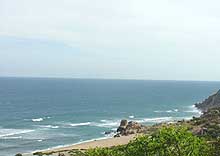On the way to Turtle Beach
Update: Jul 21, 2009
The suggestive shapes and patterns of the beautiful rocks and trees capture the eyes of visitors on the way to Bai Rua (Turtle Beach) in Vinh Hai Commune, Ninh Hai District, Ninh Thuan Province.
 Undoubtedly, the most attractive scene is the site about 400m from Provincial Road 702, where a nearly round-shaped rock sits firmly on a boulder which is nestled amidst cactus and other plants on the left of a narrow cement road leading to Turtle Beach. Undoubtedly, the most attractive scene is the site about 400m from Provincial Road 702, where a nearly round-shaped rock sits firmly on a boulder which is nestled amidst cactus and other plants on the left of a narrow cement road leading to Turtle Beach.
People can’t help stopping for a while to take pictures of the natural rock masterpiece. It does not have an official name but visitors can call it whatever name they like depending on their imagination.
Master of geography Truong Hoang Phuong, who is also director of marketing at the travel firm Vietmark, uses the phenomenon of peeling an onion’s skin or onion-skin weathering to explain why the rock connects firmly with the boulder through a small base.
Phuong said the outer layers of a rock peeled off in thin sheets under the radiant heat of the sun until it eventually becomes rounded. In other words, the change in temperature between day and night causes its layers to peel off like an onion skin coming off.
Phuong said onion-skin weathering would continue with the rock masterpiece at Turtle Beach until it breaks in half as there already exists a crack on it. However, it is difficult to say when the break will happen. No one knows how long the rock has been peeling.
Leaving the path, plants growing in different shapes beckon visitors to a good position for them to have a bird’s eye view of Turtle Beach. Nguyen Si Hung of the Ecotourism and Environmental Education Department in Ninh Thuan Province said though the trees were not tall, they might be more than 100 or hundreds of years old because they cannot grow well in a region considered the driest part of Vietnam.
Hung said many of the trees looked like the bonsai that are used as decorations in parks and buildings in cities around Vietnam. One of the older trees is more than 2m-highl. Its branches shadow beautiful rocks perched on the verge of a valley under which turtles come to lay their eggs.
Hung said turtles came ashore at Turtle Beach, also known as Bai Thit (Meat Beach) from March till November, but their peak egg laying season is from April to July. Chelonia mydas, eretmochelys imbricata and lepidochelys olivacea are the scientific names of common turtle types that have been reported laying eggs at the beach every year.
The clean beautiful beach is called Meat Beach as turtles used to be a source of meat tens of years ago when there were so many turtles there. However, local authorities have listed the beach as a specially-protected area as the creatures have dwindled significantly.
Hung said documents showed it takes 30 years for a turtle to become mature and lay eggs, and only one of the more than 1,000 baby turtles survive to mating age. To raise public awareness on protecting turtles, students and tourists are invited to participate in releasing baby turtles to the sea after they are hatched.
For further information about an organized tour to Turtle Beach, get in contact:
Ecotourism and Environmental Education Department in Ninh Thuan Province
Tel: (84-68) 2213 821
Email:vqgnuichua@gmail.com
Vietmark Co. Ltd.,
Add: 166D, Floor 1, Tran Hung Dao Boulevard, District 1, HCMC
Tel: (84-8) 5404 3939 / 5404 5404
Email: phuong@vietmark.vn
SGT
|
 |
|